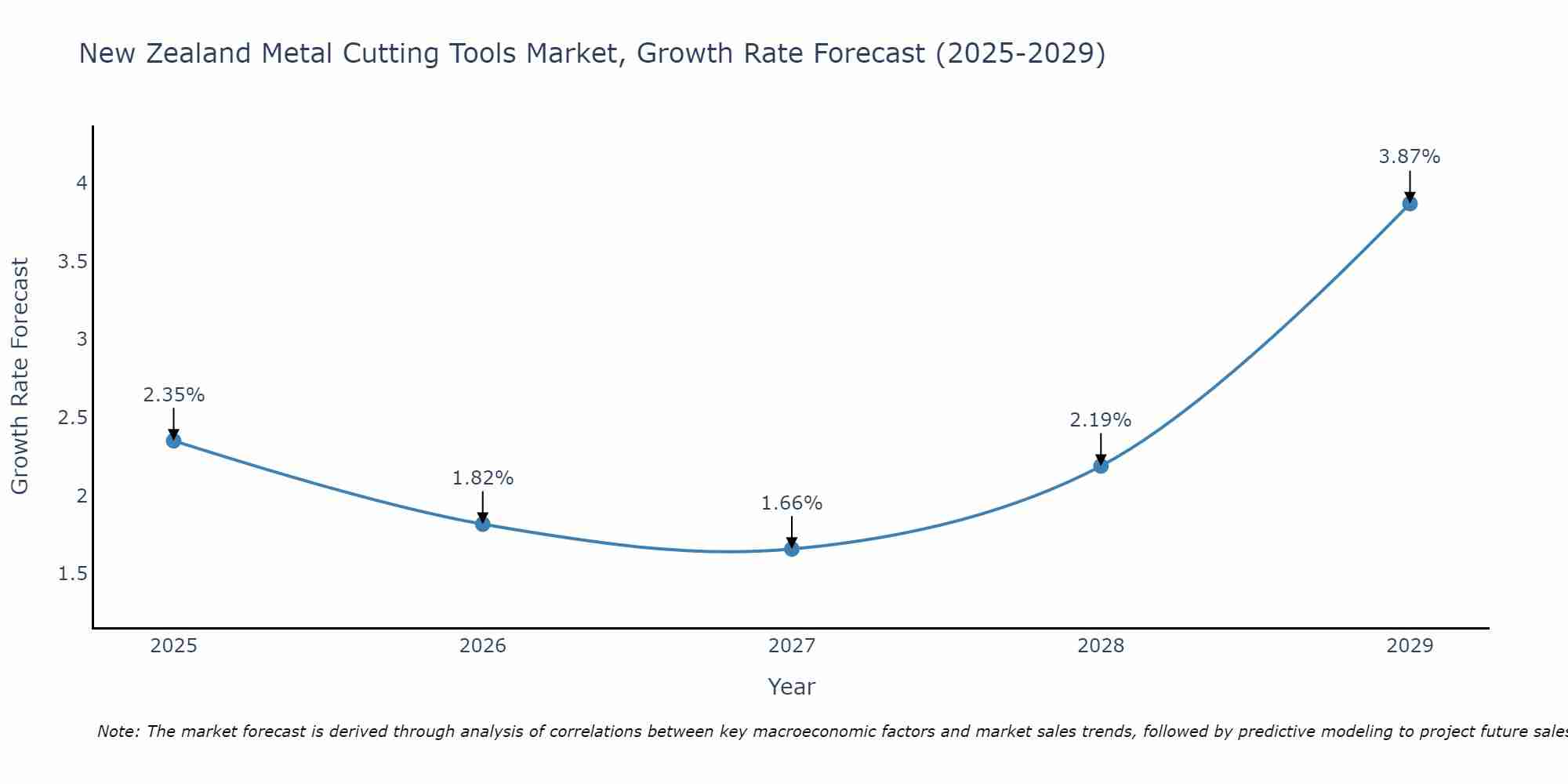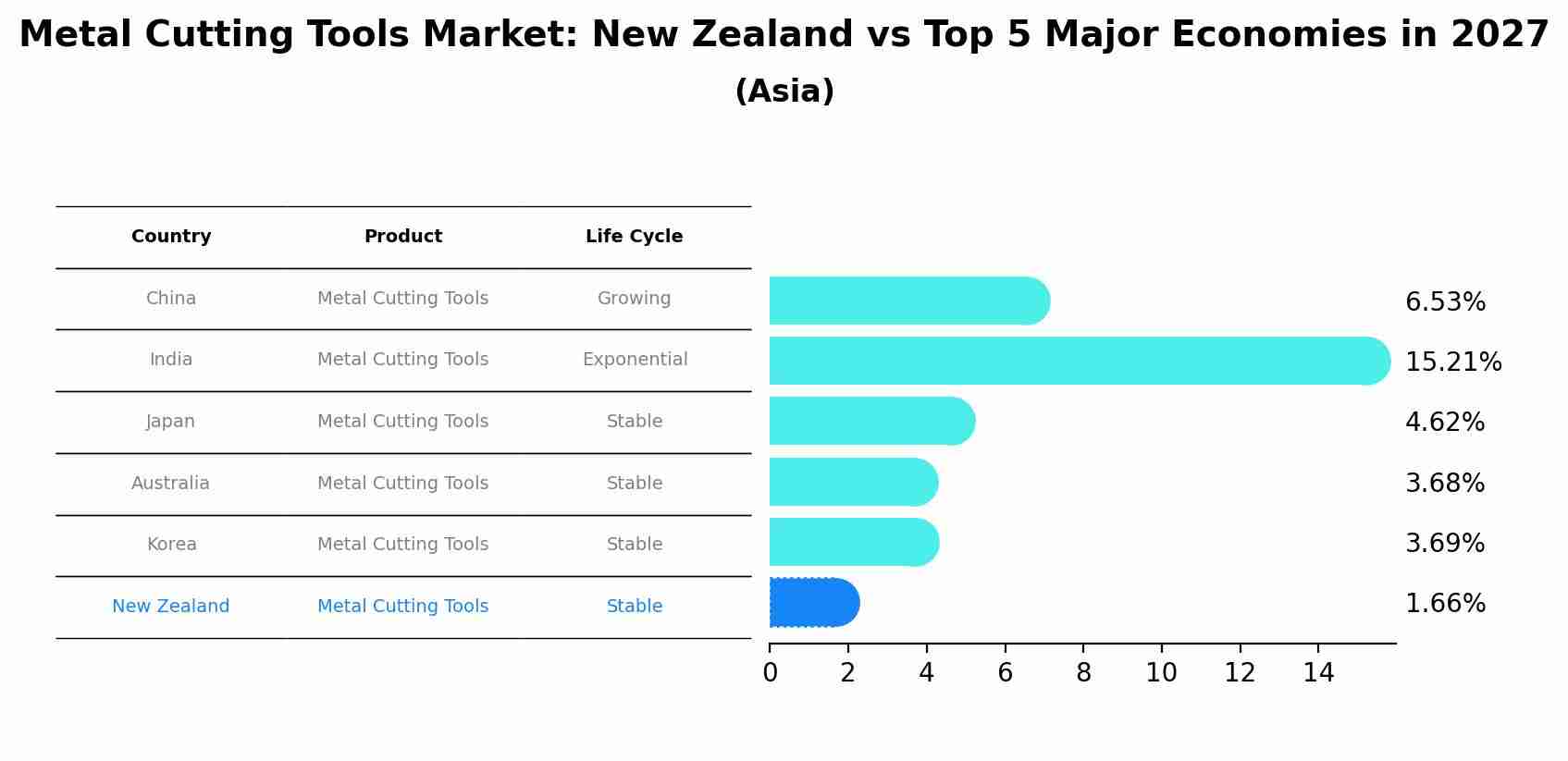New Zealand Metal Cutting Tools Market (2025-2031) | Growth, Outlook, Companies, Forecast, Trends, Size, Share, Analysis, Revenue, Segmentation, Industry & Value
| Product Code: ETC5196654 | Publication Date: Nov 2023 | Updated Date: Sep 2025 | Product Type: Market Research Report | |
| Publisher: 6Wresearch | Author: Bhawna Singh | No. of Pages: 60 | No. of Figures: 30 | No. of Tables: 5 |
New Zealand Metal Cutting Tools Market Size Growth Rate
The New Zealand Metal Cutting Tools Market is projected to witness mixed growth rate patterns during 2025 to 2029. Commencing at 2.35% in 2025, growth builds up to 3.87% by 2029.

Metal Cutting Tools Market: New Zealand vs Top 5 Major Economies in 2027 (Asia)
By 2027, the Metal Cutting Tools market in New Zealand is anticipated to reach a growth rate of 1.66%, as part of an increasingly competitive Asia region, where China remains at the forefront, supported by India, Japan, Australia and South Korea, driving innovations and market adoption across sectors.

New Zealand Metal Cutting Tools Market Overview
Precision cutting tools are crucial for shaping metal components with accuracy and efficiency. The New Zealand metal cutting tools market offers a diverse range of tools, including drills, saws, and milling cutters, catering to various industries such as manufacturing, construction, and automotive.
Drivers of the market
The New Zealand metal cutting tools market is driven by the country`s manufacturing and construction industries` demand for high-quality cutting tools to meet production and construction needs. Metal cutting tools, including drills, saws, milling cutters, and turning tools, play a crucial role in machining and fabricating metal components with precision and efficiency. In New Zealand, the adoption of advanced cutting tool materials, such as carbide and high-speed steel, is driving market growth by improving cutting performance and tool longevity. Moreover, the integration of cutting tool technologies with CNC machines and automation systems is driving market growth by enhancing productivity and reducing machining time.
Challenges of the market
In the **New Zealand Metal Cutting Tools Market**, challenges include meeting the demands for precision, efficiency, and cost-effectiveness in machining operations across diverse industries such as automotive, aerospace, and manufacturing. Rapid technological advancements drive innovation in cutting tool materials, coatings, and geometries, as well as integrated tooling systems for enhanced productivity and performance.
Government Policy of the market
Government support for the manufacturing sector and policies promoting advanced manufacturing technologies drive the metal cutting tools market. Trade agreements and import policies also play a role.
Key Highlights of the Report:
- New Zealand Metal Cutting Tools Market Outlook
- Market Size of New Zealand Metal Cutting Tools Market, 2024
- Forecast of New Zealand Metal Cutting Tools Market, 2031
- Historical Data and Forecast of New Zealand Metal Cutting Tools Revenues & Volume for the Period 2021-2031
- New Zealand Metal Cutting Tools Market Trend Evolution
- New Zealand Metal Cutting Tools Market Drivers and Challenges
- New Zealand Metal Cutting Tools Price Trends
- New Zealand Metal Cutting Tools Porter`s Five Forces
- New Zealand Metal Cutting Tools Industry Life Cycle
- Historical Data and Forecast of New Zealand Metal Cutting Tools Market Revenues & Volume By Product for the Period 2021-2031
- Historical Data and Forecast of New Zealand Metal Cutting Tools Market Revenues & Volume By Machining Centers for the Period 2021-2031
- Historical Data and Forecast of New Zealand Metal Cutting Tools Market Revenues & Volume By Lathe Machines for the Period 2021-2031
- Historical Data and Forecast of New Zealand Metal Cutting Tools Market Revenues & Volume By Boring Machines for the Period 2021-2031
- Historical Data and Forecast of New Zealand Metal Cutting Tools Market Revenues & Volume By Grinding Machines for the Period 2021-2031
- Historical Data and Forecast of New Zealand Metal Cutting Tools Market Revenues & Volume By Milling Machines for the Period 2021-2031
- Historical Data and Forecast of New Zealand Metal Cutting Tools Market Revenues & Volume By Others for the Period 2021-2031
- Historical Data and Forecast of New Zealand Metal Cutting Tools Market Revenues & Volume By Application for the Period 2021-2031
- Historical Data and Forecast of New Zealand Metal Cutting Tools Market Revenues & Volume By Automotive for the Period 2021-2031
- Historical Data and Forecast of New Zealand Metal Cutting Tools Market Revenues & Volume By General Machinery for the Period 2021-2031
- Historical Data and Forecast of New Zealand Metal Cutting Tools Market Revenues & Volume By Precision Engineering for the Period 2021-2031
- Historical Data and Forecast of New Zealand Metal Cutting Tools Market Revenues & Volume By Transport Machinery for the Period 2021-2031
- Historical Data and Forecast of New Zealand Metal Cutting Tools Market Revenues & Volume By Others for the Period 2021-2031
- New Zealand Metal Cutting Tools Import Export Trade Statistics
- Market Opportunity Assessment By Product
- Market Opportunity Assessment By Application
- New Zealand Metal Cutting Tools Top Companies Market Share
- New Zealand Metal Cutting Tools Competitive Benchmarking By Technical and Operational Parameters
- New Zealand Metal Cutting Tools Company Profiles
- New Zealand Metal Cutting Tools Key Strategic Recommendations
Frequently Asked Questions About the Market Study (FAQs):
1 Executive Summary |
2 Introduction |
2.1 Key Highlights of the Report |
2.2 Report Description |
2.3 Market Scope & Segmentation |
2.4 Research Methodology |
2.5 Assumptions |
3 New Zealand Metal Cutting Tools Market Overview |
3.1 New Zealand Country Macro Economic Indicators |
3.2 New Zealand Metal Cutting Tools Market Revenues & Volume, 2021 & 2031F |
3.3 New Zealand Metal Cutting Tools Market - Industry Life Cycle |
3.4 New Zealand Metal Cutting Tools Market - Porter's Five Forces |
3.5 New Zealand Metal Cutting Tools Market Revenues & Volume Share, By Product, 2021 & 2031F |
3.6 New Zealand Metal Cutting Tools Market Revenues & Volume Share, By Application, 2021 & 2031F |
4 New Zealand Metal Cutting Tools Market Dynamics |
4.1 Impact Analysis |
4.2 Market Drivers |
4.2.1 Growth in the manufacturing sector in New Zealand |
4.2.2 Technological advancements in metal cutting tools |
4.2.3 Increasing demand for precision engineering products |
4.3 Market Restraints |
4.3.1 Fluctuating raw material prices |
4.3.2 Competition from substitute materials like ceramics and composites |
5 New Zealand Metal Cutting Tools Market Trends |
6 New Zealand Metal Cutting Tools Market Segmentations |
6.1 New Zealand Metal Cutting Tools Market, By Product |
6.1.1 Overview and Analysis |
6.1.2 New Zealand Metal Cutting Tools Market Revenues & Volume, By Machining Centers, 2021-2031F |
6.1.3 New Zealand Metal Cutting Tools Market Revenues & Volume, By Lathe Machines, 2021-2031F |
6.1.4 New Zealand Metal Cutting Tools Market Revenues & Volume, By Boring Machines, 2021-2031F |
6.1.5 New Zealand Metal Cutting Tools Market Revenues & Volume, By Grinding Machines, 2021-2031F |
6.1.6 New Zealand Metal Cutting Tools Market Revenues & Volume, By Milling Machines, 2021-2031F |
6.1.7 New Zealand Metal Cutting Tools Market Revenues & Volume, By Others, 2021-2031F |
6.2 New Zealand Metal Cutting Tools Market, By Application |
6.2.1 Overview and Analysis |
6.2.2 New Zealand Metal Cutting Tools Market Revenues & Volume, By Automotive, 2021-2031F |
6.2.3 New Zealand Metal Cutting Tools Market Revenues & Volume, By General Machinery, 2021-2031F |
6.2.4 New Zealand Metal Cutting Tools Market Revenues & Volume, By Precision Engineering, 2021-2031F |
6.2.5 New Zealand Metal Cutting Tools Market Revenues & Volume, By Transport Machinery, 2021-2031F |
6.2.6 New Zealand Metal Cutting Tools Market Revenues & Volume, By Others, 2021-2031F |
7 New Zealand Metal Cutting Tools Market Import-Export Trade Statistics |
7.1 New Zealand Metal Cutting Tools Market Export to Major Countries |
7.2 New Zealand Metal Cutting Tools Market Imports from Major Countries |
8 New Zealand Metal Cutting Tools Market Key Performance Indicators |
8.1 Adoption rate of advanced metal cutting technologies in New Zealand |
8.2 Number of manufacturing facilities investing in upgrading metal cutting tools |
8.3 Rate of innovation in metal cutting tool designs and features |
9 New Zealand Metal Cutting Tools Market - Opportunity Assessment |
9.1 New Zealand Metal Cutting Tools Market Opportunity Assessment, By Product, 2021 & 2031F |
9.2 New Zealand Metal Cutting Tools Market Opportunity Assessment, By Application, 2021 & 2031F |
10 New Zealand Metal Cutting Tools Market - Competitive Landscape |
10.1 New Zealand Metal Cutting Tools Market Revenue Share, By Companies, 2024 |
10.2 New Zealand Metal Cutting Tools Market Competitive Benchmarking, By Operating and Technical Parameters |
11 Company Profiles |
12 Recommendations | 13 Disclaimer |
- Single User License$ 1,995
- Department License$ 2,400
- Site License$ 3,120
- Global License$ 3,795
Search
Related Reports
- Saudi Arabia Manlift Market (2025-2031) | Outlook, Size, Growth, Trends, Companies, Industry, Revenue, Value, Share, Forecast & Analysis
- Uganda Excavator, Crane, and Wheel Loaders Market (2025-2029) | Strategy, Consumer Insights, Analysis, Investment Trends, Opportunities, Growth, Size, Share, Industry, Revenue, Segments, Value, Segmentation, Supply, Forecast, Restraints, Outlook, Competition, Drivers, Trends, Demand, Pricing Analysis, Competitive, Strategic Insights, Companies, Challenges
- Rwanda Excavator, Crane, and Wheel Loaders Market (2025-2031) | Strategy, Consumer Insights, Analysis, Investment Trends, Opportunities, Growth, Size, Share, Industry, Revenue, Segments, Value, Segmentation, Supply, Forecast, Restraints, Outlook, Competition, Drivers, Trends, Demand, Pricing Analysis, Competitive, Strategic Insights, Companies, Challenges
- Kenya Excavator, Crane, and Wheel Loaders Market (2025-2031) | Strategy, Consumer Insights, Analysis, Investment Trends, Opportunities, Growth, Size, Share, Industry, Revenue, Segments, Value, Segmentation, Supply, Forecast, Restraints, Outlook, Competition, Drivers, Trends, Demand, Pricing Analysis, Competitive, Strategic Insights, Companies, Challenges
- Angola Excavator, Crane, and Wheel Loaders Market (2025-2031) | Strategy, Consumer Insights, Analysis, Investment Trends, Opportunities, Growth, Size, Share, Industry, Revenue, Segments, Value, Segmentation, Supply, Forecast, Restraints, Outlook, Competition, Drivers, Trends, Demand, Pricing Analysis, Competitive, Strategic Insights, Companies, Challenges
- Israel Intelligent Transport System Market (2025-2031) | Strategy, Consumer Insights, Analysis, Investment Trends, Opportunities, Growth, Size, Share, Industry, Revenue, Segments, Value, Segmentation, Supply, Forecast, Restraints, Outlook, Competition, Drivers, Trends, Demand, Pricing Analysis, Competitive, Strategic Insights, Companies, Challenges
- Uganda Precast and Aggregate Market (2025-2031) | Strategy, Consumer Insights, Analysis, Investment Trends, Opportunities, Growth, Size, Share, Industry, Revenue, Segments, Value, Segmentation, Supply, Forecast, Restraints, Outlook, Competition, Drivers, Trends, Demand, Pricing Analysis, Competitive, Strategic Insights, Companies, Challenges
- Australia IT Asset Disposal Market (2025-2031) | Strategy, Consumer Insights, Analysis, Investment Trends, Opportunities, Growth, Size, Share, Industry, Revenue, Segments, Value, Segmentation, Supply, Forecast, Restraints, Outlook, Competition, Drivers, Trends, Demand, Pricing Analysis, Competitive, Strategic Insights, Companies, Challenges
- UAE Building Thermal Insulation Market Outlook (2025-2031) | Revenue, Companies, Share, Trends, Growth, Size, Forecast, Industry, Analysis & Value
- Portugal Electronic Document Management Market (2025-2031) | Strategy, Consumer Insights, Analysis, Investment Trends, Opportunities, Growth, Size, Share, Industry, Revenue, Segments, Value, Segmentation, Supply, Forecast, Restraints, Outlook, Competition, Drivers, Trends, Demand, Pricing Analysis, Competitive, Strategic Insights, Companies, Challenges
Industry Events and Analyst Meet
Our Clients
Whitepaper
- Middle East & Africa Commercial Security Market Click here to view more.
- Middle East & Africa Fire Safety Systems & Equipment Market Click here to view more.
- GCC Drone Market Click here to view more.
- Middle East Lighting Fixture Market Click here to view more.
- GCC Physical & Perimeter Security Market Click here to view more.
6WResearch In News
- Doha a strategic location for EV manufacturing hub: IPA Qatar
- Demand for luxury TVs surging in the GCC, says Samsung
- Empowering Growth: The Thriving Journey of Bangladesh’s Cable Industry
- Demand for luxury TVs surging in the GCC, says Samsung
- Video call with a traditional healer? Once unthinkable, it’s now common in South Africa
- Intelligent Buildings To Smooth GCC’s Path To Net Zero













